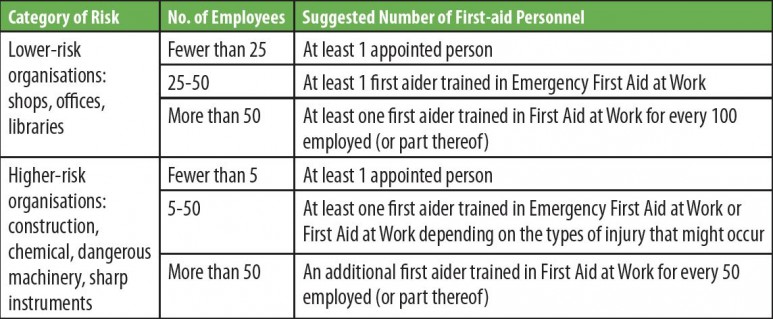Assessing First Aid Needs
 Employers are required to provide adequate and appropriate equipment, facilities and personnel to ensure their employees (and others when deemed necessary) receive immediate attention if they are injured or taken ill at work.
Employers are required to provide adequate and appropriate equipment, facilities and personnel to ensure their employees (and others when deemed necessary) receive immediate attention if they are injured or taken ill at work.
What qualifies as “adequate and appropriate” will depend on the circumstances of each employing organisation but to determine this, those responsible for first-aid provisions should carry out an assessment of first-aid needs.
The Approved Code of Practice to the Health and Safety (First-aid) Regulations 1981 (FAR) recommends that a number of factors be taken into account when determining first- aid needs, including:
- The hazards and risks associated with work activities
- The size of the organisation and its history of accidents
- The nature and distribution of the workforce
- The needs of lone workers and working patterns
- The possible absence of first aid personnel.
Other factors may influence the level of provision, including the remoteness of the premises from emergency services and hospitals or the findings of incident statistics and investigations.
The Approved Code of Practice to FAR notes that where the work involves specific hazards, first-aid requirements will be greater and employers may then need to consider additional first-aid equipment and the precise siting of this equipment.
Determining the Number of First Aid Personnel Needed
The following table gives an indication of the numbers of First Aid personnel required according to the number of employees, on the assumption that the more employees there are, the greater the probability of injury or illness.
First-aid box contents
Take a look at our updated article with the latest British Standard BS 8599-1:2019 here
Eye Wash
If mains tap water is not readily available for eye irrigation, at least a litre of sterile water or sterile normal saline (0.9%) in sealed, disposable containers should be provided. Once the seal is broken, the solutions should not be kept for reuse. Solutions should not be used beyond their expiry date.
Additional Materials and Equipment
If the first-aid assessment and the likely response time of the emergency services suggest that some means of moving a patient is necessary, such as a stretcher or evacuation chair, it should be stored in a place that is secure, yet readily available for use. It is important that anyone expected to use it must be fully trained in its correct use, as the injuries that could result from its misuse could lead to litigation for the organisation.
It is possible that the circumstances of the rescue or treatment of an injured person place the first aider at sufficient risk to require some form of personal protective equipment, e.g. a hard hat or some form of protective garment. In addition, it may be necessary to provide blankets or some other form of protection for the patient. Where these are necessary they should be readily available for use but secure from misuse or accidental damage. Their positioning will depend on the need, e.g. it may be appropriate to:
- Issue the equipment to individual first aiders trained in its use
- Hold it in a central (secure) location
- Site the equipment near to the area where the risk that may require its use is situated.
There is more information about workplace first aid assessments in our guide to first aid in the office.

